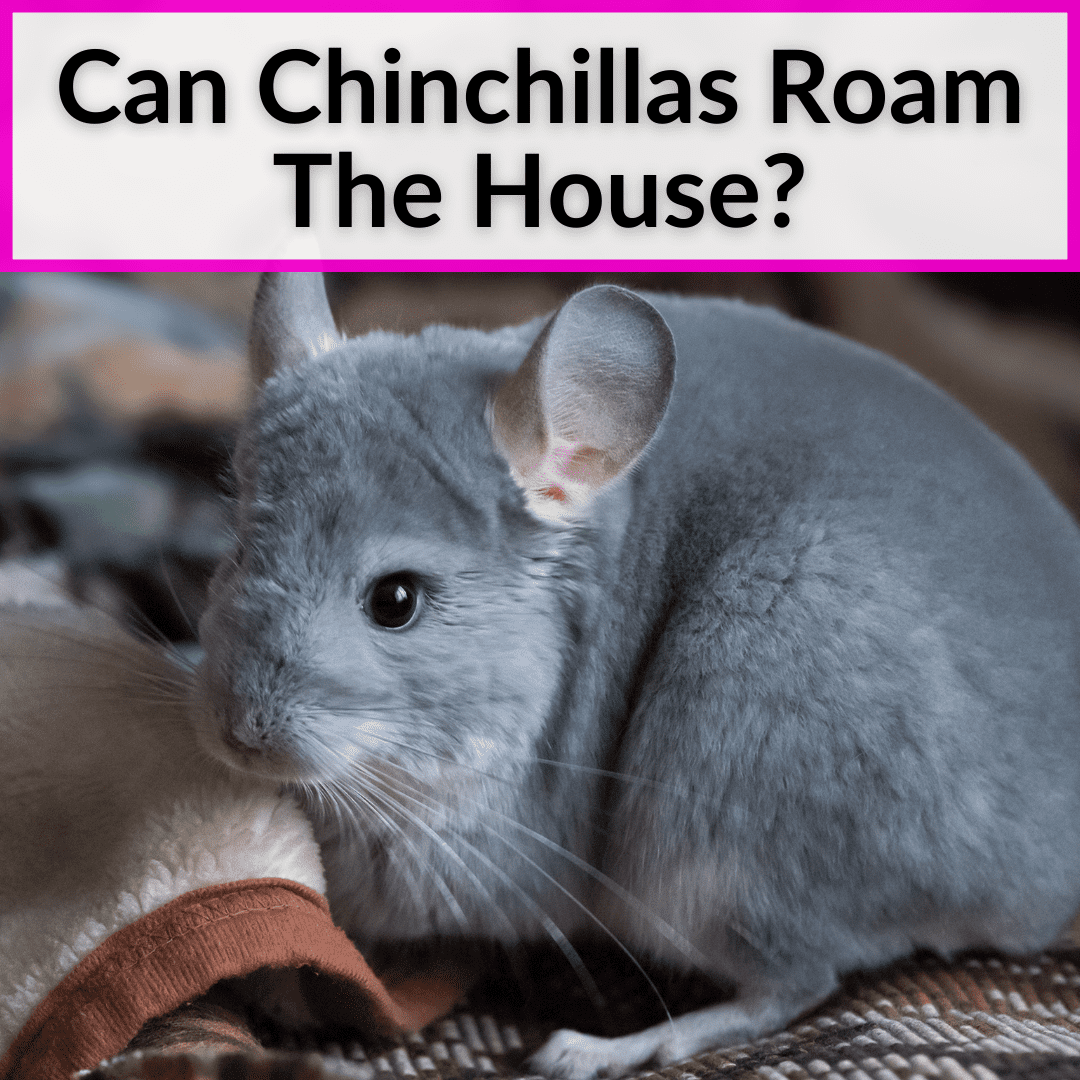
Cats generally enjoy the same freedom.
But that is not usually the case with smaller animals like hamsters or other little rodents.
There are simply too many dangers in the home for an animal so small.
Does the same hold true for chinchillas? Or can chinchillas roam the house freely?
It’s actually not a simple yes or no answer. It depends on a few things.
Keep reading to learn when chinchillas can roam freely and when they can’t.
We’ll also cover the best ways to conduct playtime and what you can do to locate a missing chinchilla that decided to hide somewhere in the home (this is never easy).
Contents
- 1 Can Chinchillas Roam The House?
- 2 Chinchillas Free-Roaming The House
- 3 7 Reasons Chinchillas Should Not Roam Your Home
- 4 3 Other Problems With Your Chinchilla Roaming Your Home
- 5 7 Alternatives To Free-Roaming The Home
- 5.1 #1: A Chinchilla Safe Room
- 5.2 #2: Cord Protectors And Covers For Electrical Cords
- 5.3 #3: No Other Pets in The Other Area
- 5.4 #4: Keep All Exterior Doors And Windows Closed
- 5.5 #5: A Tent Or Playpen For Your Chinchilla
- 5.6 #6: Always Have A Proper Sized Cage for Your Chinchilla
- 5.7 #7: A Bathroom Is Good Option For Playtime
- 6 6 Ways To Find A Missing Chinchilla In Your Home
- 7 Chinchilla Roaming The Home: Final Thoughts
Can Chinchillas Roam The House?
A chinchilla can roam freely in rooms that have been fully chinchilla proofed. But there are simply too many dangers in areas that have not been made safe.
Chinchillas like to chew, which could be fatal, if your pet chews through an electrical cord. These tiny rodents can also be difficult to find, if they get access to areas of the home not chinchilla proofed.
So, what do you do?
What’s the best course of action to ensure your chinchilla has plenty of space to play?
Additionally, what rooms of the home are considered safe, and what are the best practices you can put into place to make owning a chinchilla easy and enjoyable?
Having a basic understanding of chinchilla behaviors inside and outside the cage is a great starting point.
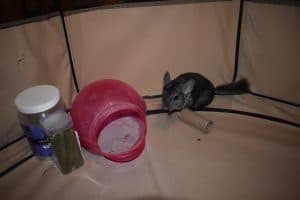
😕Adopting and caring for a new chinchilla can be intimidating and confusing. But it does not have to be.
Be sure to check out my full digital eBook “Avoiding Critical Mistakes: Ultimate Chinchilla Care eBook” to get the best advice, tips, and tricks and supply recommendations to make adopting and caring for a chinchilla much more comfortable and easier to understand.
You can learn more about this eBook offer using the link directly below.
Learn more here:👉 Avoiding Critical Mistakes: Ultimate Chinchilla Care eBook Offer
Chinchillas Free-Roaming The House
If you decide that you want your chinchilla to have the ability to free-roam more of the house, you need to make sure it can do so safely..
For that reason, I almost always advise against allowing a chinchilla to free-roam in this manner. It is very difficult to ensure that a good majority of the house if properly chinchilla-proofed.
This means that no cords are exposed for your chinchilla to chew and that no other dangers to your pet are present.
While it is 100% possible to chinchilla proof a room or two of the home, the likelihood that you are able to do a good job of proofing the entire home is slim to none.
However, this is completely your call and it is your chinchilla.
To make this simple to understand, if you feel comfortable with your chinchilla free-roaming and you believe it is safe, feel free to do so.
On the other hand, if you do not feel that your chinchilla is safe doing this style of free roam, you should avoid it and consider other options.
I always recommend something like a playpen for your chinchilla in the beginning. I am a big fan of the JesPet playpen and have been using it for the past 4 years. You can read about it in my article covering the best chinchilla playpens.
I will detail the playpen approach in more depth later in this post. For now, I wanted to give you the option to get some of this information in video form. But know that the article covers a lot more than the video does.
We touched on why it is not a good idea to let your chinchilla freely roam the house, but let’s dive into that a bit more.
7 Reasons Chinchillas Should Not Roam Your Home
These are the 7 major reasons it is not a good idea to let your chinchilla wander around the home as it pleases.
#1: Electrical Cords
Chinchillas love to chew and bite on various objects. They will chew their cage bars, nibble on treats, and just about anything they can find or access.
No worries, most chinchillas don’t bite humans in most circumstances.
However, if you are anything like me and have several rooms in your home, it’s highly unlikely all electrical cords have cord protectors on them.
If your chinchilla can find a way to get to them and begins chewing, this can become problematic for obvious reasons.
Ultimately, it could even lead to your chinchilla being killed by the electrical shock. This alone is a good reason not to allow your chinchilla to roam the house freely. A safe chinchilla room is the only way to go.
#2: Other Unsafe Or Toxic Items
Let’s assume your chinchilla doesn’t find any electrical cords to chew.
Given how easily chinchillas can jump and climb, it is likely it will find other items in the home that can potentially pose a threat.
This may include household cleaners, or even various plants. Your chinchilla should always be in the same room as you, so you can supervise, when it is out of the cage.
#3: Difficulty Locating Your Chinchilla
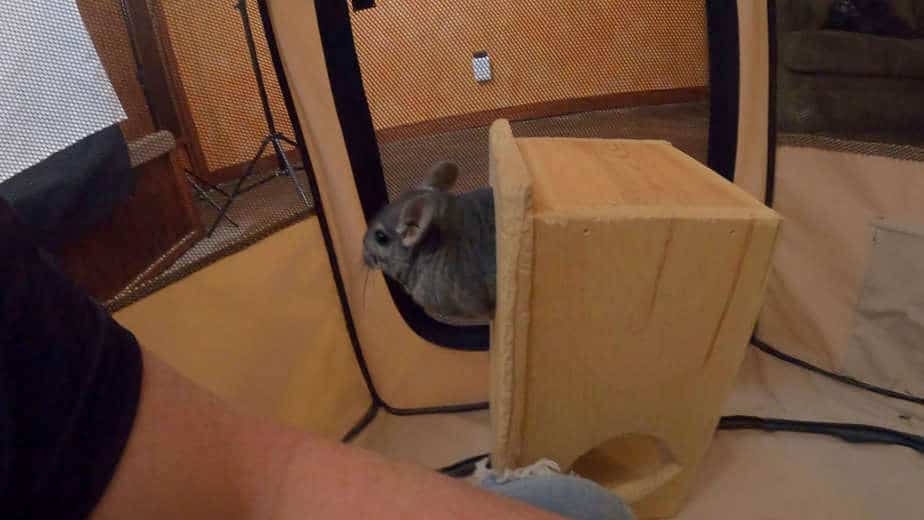
Chinchillas are not only masters at climbing and jumping. They are also kings of hide and go seek.
When a chinchilla can break free in your home and can roam around, there is a good chance it will wedge itself into a clever hiding spot.
Chinchilla owners on forums and Facebook communities have even shared that it has sometimes taken over 24 hours to find their chinchilla.
I can’t even imagine this feeling of having no clue where my chinchilla could be. Could you imagine all the places inside 1 home where a chinchilla may be hiding?
- Mattresses
- Couch cushions
- Closets
- Under dressers
And those are just some easy ones. The list could literally go on and on for hours. They find places to hide you would never even think of.
The point is simple. If you don’t want to be searching for your chinchilla all night instead of sleeping, then you need to keep other areas of your home blocked off and not allow your chinchilla to roam your house freely.
#4: You Could Step On Your Chinchilla
This is rare, but it’s possible. Especially if you have kids running around the home.
When your pet is running loose around the house and several people are running around, too, it’s possible someone might accidentally step on your beloved chin.
These little rodents have incredibly fragile bones that are paper-thin. It’s just not worth the risk.
#5: Temperature Control Is Imperative
I personally keep my chinchilla in my basement.
I do this for the mere fact that I know it’s the correct temperatures for my chinchilla. That eliminates the need to worry about my chinchilla overheating and heatstroke.
The rest of my home is usually around 70 to 72 degrees. I’m aware that these temperatures may be okay, but I prefer to do better than okay and keep my chinchilla not only safe, but comfortable.
My basement is usually 5 to 7 degrees cooler than the rest of my home. That is perfect for my chin.
If your chinchilla gets loose in other areas of the home, it’s entirely possible that the room your chinchilla ends up hiding out in may be too hot for it. It could overheat and ultimately die.
It’s not a risk worth taking in the grand scheme of chinchilla playtime options.
#6: Chinchillas Poop And Pee A Lot
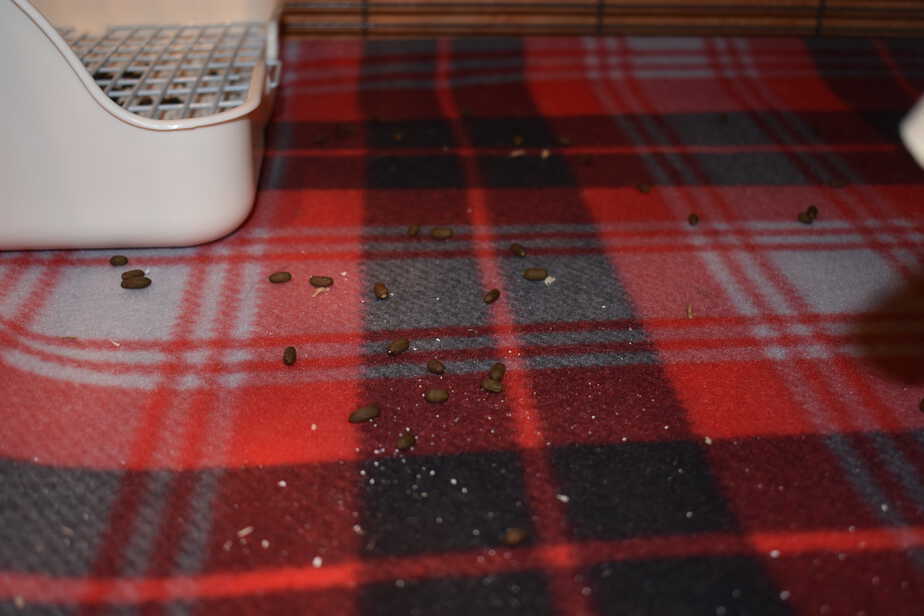
This may not be a danger to your chinchilla, but it’s undoubtedly a danger to your floors and home. At the very least, a nuisance.
Chinchillas poop about every step they take. They defecate more than 200 times per day. If your chinchilla is roaming around your house, you will have plenty of poop nuggets to clean up.
Additionally, chinchillas will pee when they are out of the cage. This could potentially happen in a spot you don’t notice right away, if you are letting your chinchilla run freely everywhere around the house.
#7: The Possibility Of Exiting An Exterior Door Or Window
People enter and leave the home throughout the day. They also open and close windows. It’s how it works.
If your chinchilla has access to your entire house, you have another big problem. If somebody arrives home and opens a door, your chinchilla is extremely fast and could quickly run right past them.
Not to mention how high chinchillas can jump and climb. If a window is open, it would also be easy for your chinchilla to reach the outside of the home.
Once your chinchilla gets outside, it’s unlikely that you will be able to find it. They are too fast and can fit into far too small a space.
Additionally, the chances of your chinchilla surviving other predators, or even the weather, are very slim. This is a significant danger you run when allowing your chinchilla to run around the house freely.
Now that we have covered the 7 main reasons not to allow your chinchilla to roam the home freely, let’s discuss a few other considerations.
You need to keep these in mind before taking the chance and allowing free chinchilla playtime in a large square foot house.
3 Other Problems With Your Chinchilla Roaming Your Home
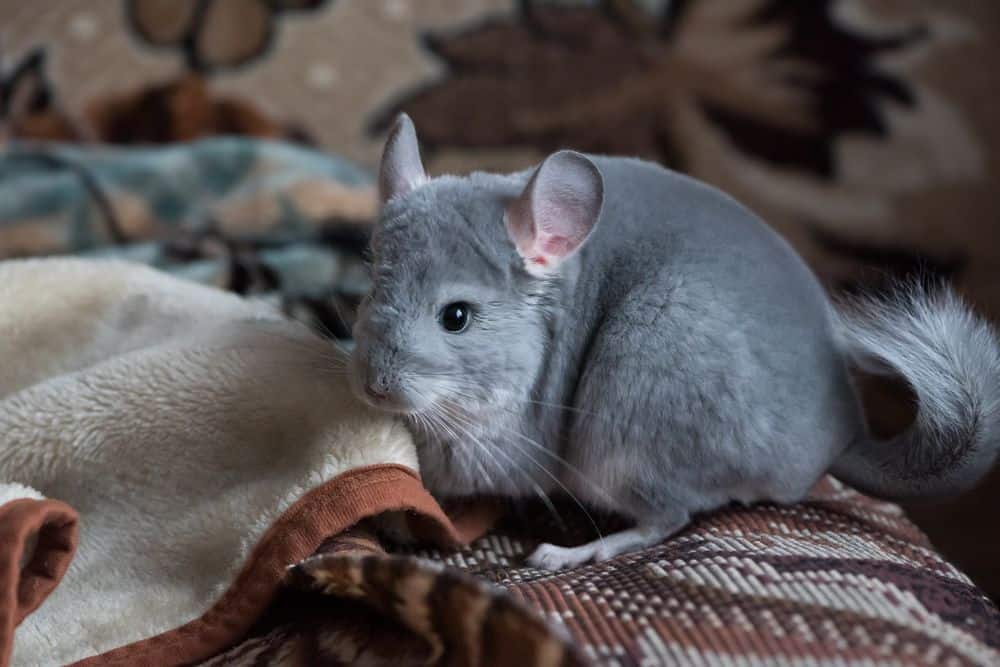
If you are thinking about letting your pet roam freely despite the previous 7 points, here are another 3 problems you need to consider.
#1: Chinchillas Are Small And Fragile
We already discussed the danger of someone stepping on your chinchilla. What we didn’t mention are the dangers your chinchilla could bring on itself.
Always remember how well chinchillas can jump and climb. If they get to a high structure and fall or land incorrectly, you could have a substantial chinchilla injury on your hands.
They could also knock something loose and have it fall on them, crushing them.
Chinchillas are just not meant to be in huge areas with dangerous items and dangerous heights presents. Not if you ask me at least.
#2: Other Pets In The Home
Some people get lucky and they have a chinchilla and another animal that behave around each other.
This is most often the case with other small rodent pets. Some have even had luck with chinchillas interacting with pets like dogs.
But this is rare.
It is unlikely you will be able to keep your dog calm enough around your chinchilla for the chinchilla to remain safe. Your dog will naturally be curious and confused.
It may chase your chinchilla, or just frighten it, which can cause overheating. It could also bite your chinchilla, or pick it up, or step on it, or paw at it.
In all honesty, if you own a dog and a chinchilla, the dog is likely the most significant danger your chinchilla will face, if the two are roaming around the same home at the same time, without limitations.
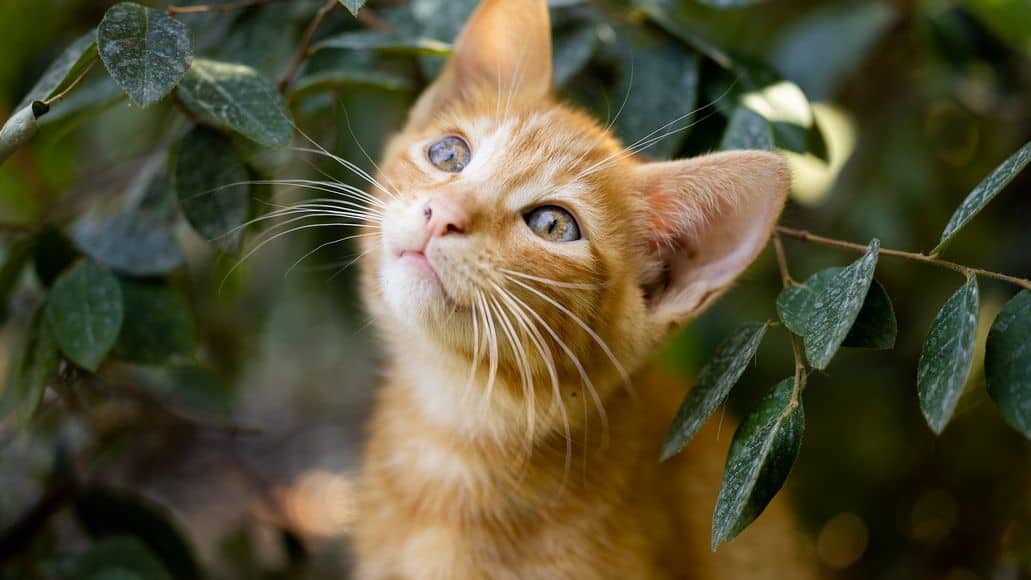
This and overheating will probably be your two most significant dangers to avoid at all costs.
#3: Other Rooms Could Overheat Your Chinchilla
Not all rooms of your house are going to be at the ideal temperatures for your chinchilla. It’s essential that your chinchilla is always between roughly 60 and 70 degrees and with low humidity levels.
My chinchilla, for example, needs my basement to accomplish this. My house itself is usually warmer than this. If your house is above this temperature, that’s okay.
A few degrees won’t cause a chinchilla to pass away or overheat during normal playtimes.
However, if your chinchilla is running and hiding in a warmer room, or wedging into a couch cushion or other item around the house, you could run into problems.
Chinchillas just don’t make for good free-roaming pets. If you want that, get a cat or dog.
But chinchillas do make for excellent pets overall, if you follow some simple instructions and keep an eye on the situation with your chinchilla.
Since we know chinchillas aren’t supposed to be roaming free around the house, what alternatives do you have?
Well, you have 7 great alternative options to choose to create a fun playtime for your chinchilla. Let’s take a look.
7 Alternatives To Free-Roaming The Home
Here are some great ideas for chinchilla playtime that don’t involve your vulnerable little pet running around the house freely.
#1: A Chinchilla Safe Room
Limit your chinchilla’s roaming space to one room. You can either close the door to the room, or use other ingenious mechanisms such as 2×4’s or stack some boxes, if it’s an open-door frame instead of a door that can close.
It’s perfectly fine for your chinchilla to roam an entire room with you supervising, if the entire room is chinchilla proofed.
This includes covering or removing cords that your chinchilla could chew and ensuring other pets are not present in the room with your chinchilla.
Other pets could be harmful, as we discussed previously, and cords present a danger, which we will consider next.\
#2: Cord Protectors And Covers For Electrical Cords
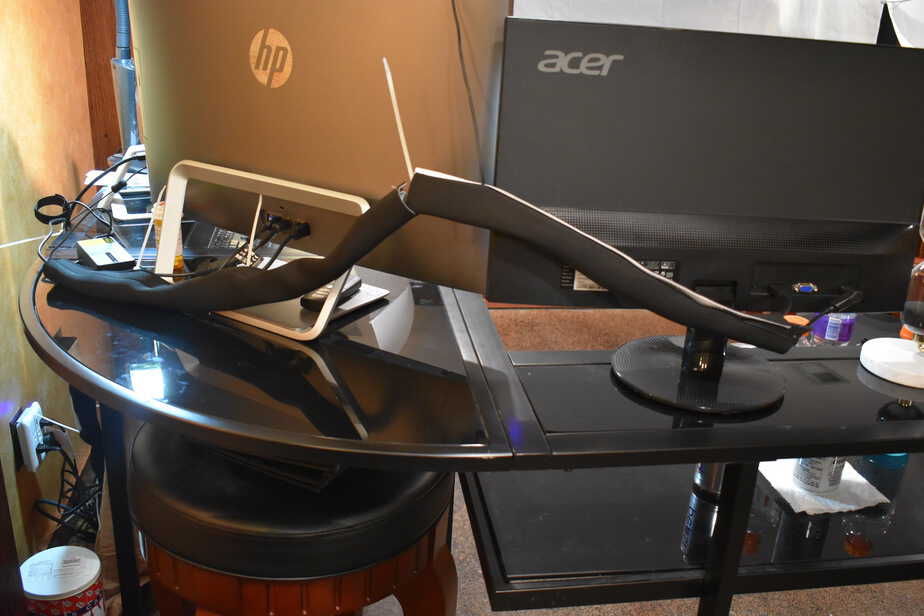
Cords are one of the biggest dangers to your chinchilla when running freely in a room. This is because they love to chew and can easily take a shock if they find a nice tasty electrical cord to take a bite of.
The solution is to purchase cord wrappings and cord covers. You can find these on Amazon or any home department store and they cost very little.
Get yourself a large roll of the chord coverings and cover any cords in the room where you intend on having your chinchilla.
This opens more space for your chinchilla to roam, keeps it safe, and also makes your house look that much better in the process.
It’s a win for everyone, if you ask me.
#3: No Other Pets in The Other Area
We mentioned how other pets like dogs or cats can be the biggest danger to your chinchilla. Well, just eliminate the problem.
Take your dogs and place them behind a door in another room until the end of playtime. You can also consider just placing your dog in a kennel for the time being, until your playtime is over with for the day.
Your other pets will be just fine, and this ensures nothing gets too out of control during playtime.
I’m personally in the works of trying to slowly introduce my dog to my chinchilla. If I have any success with this process, I will be sure to keep you posted.\
#4: Keep All Exterior Doors And Windows Closed
Close all doors and windows. Another thing to keep in mind if you have a young chinchilla is to block the bottom of the door.
When chinchillas are babies, they are much smaller, and they still have collapsible ribs. They might be able to squeeze through the gap under the door, so block it just in case.
If your pet squeezes under the door, it will be free-roaming your home whether you like it or not. And that opens up all the problems we already discussed. Better to be safe than sorry.
#5: A Tent Or Playpen For Your Chinchilla
This works fantastic. I use one myself at my house. My basement is unsafe, and none of the doorways have doors. Not to mention, the stairs lead straight upstairs to where my big dog is located.
For that reason, I use a playpen type tent that’s 5 feet tall by 6 feet wide. I ordered it on Amazon, and it’s straightforward to fold up and unfold for use.
Refer to my post about the best chinchilla playpens for more information. I use the Jespet model, which is the one listed first in that article.
My chinchilla can still jump and play with ease in the tent and hasn’t shown any signs of complaints.
Although, I’m not going to lie. I’m excited to get out of the playpen when we move into our new home and open up much more space for her.
#6: Always Have A Proper Sized Cage for Your Chinchilla
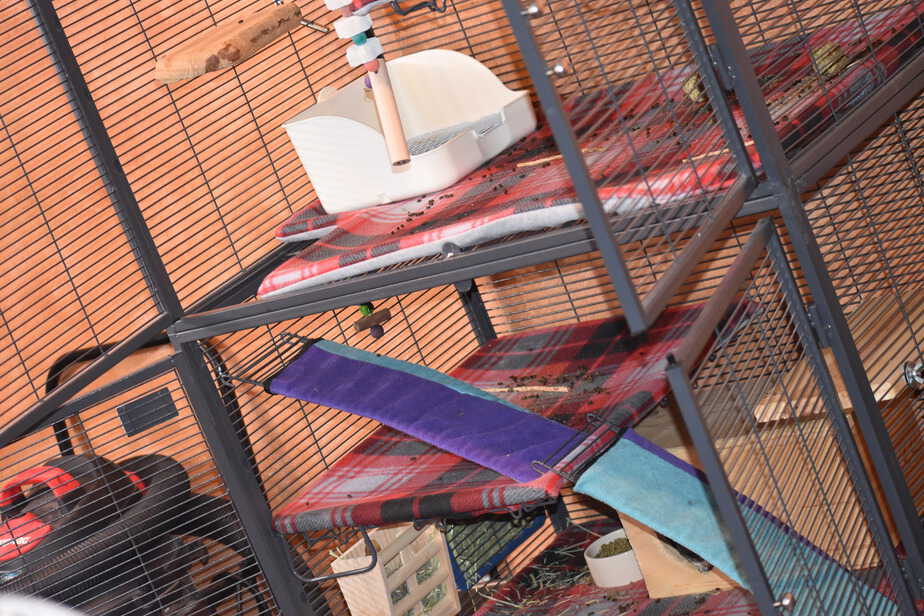
Even if you are the best chinchilla owner in the world and always dedicate an hour a day to play and interact with your chinchilla, that does not mean that you get to skimp on the cage and just get a tiny one.
Chinchillas need plenty of room to maneuver and play. They also need plenty of space to jump, climb, and do all the natural chinchilla type behaviors.
It’s important. It keeps your chinchilla happy and healthy.
I always recommend the 2-level Critter Nation cage. If you have multiple chinchillas, this is the absolute bare minimum size cage to get.
If you are strapped for cash and on a budget and need something slightly cheaper, you could also go with the single-level Critter Nation cage.
But I highly recommend you consider upgrading in the future and adding the second level to the cage.
#7: A Bathroom Is Good Option For Playtime
Not enough chinchilla owners discuss the magic of a bathroom for playtime with a chinchilla.
They work fantastic.
Make sure to close the toilet lid and don’t have any access to harmful cleaners or other agents that could hurt your pet. Outside of this, bathrooms provide enough space for your chinchilla to run and jump and be a silly little chin.
They are safe, usually free of electrical cords, and just simple rooms to allow your chinchilla time to roam around and enjoy playtime.
It’s that easy. Use a bathroom!
One thing we’ve mentioned a few times already in this post is how hard it can be to find your chinchilla, if it is hiding somewhere.
So what do you do when you need to find a chinchilla that did happen to get some free-roaming time around the house?
First and foremost, I can tell you that’s it’s probably not going to be easy.
If you have any chance of making it happen, you’re going to use one of the following 6 techniques.
6 Ways To Find A Missing Chinchilla In Your Home
If you need to find a missing chinchilla, try one of these 6 tricks. Hopefully you will get lucky with one of them.
#1: Chinchilla Treats Always Work Wonders
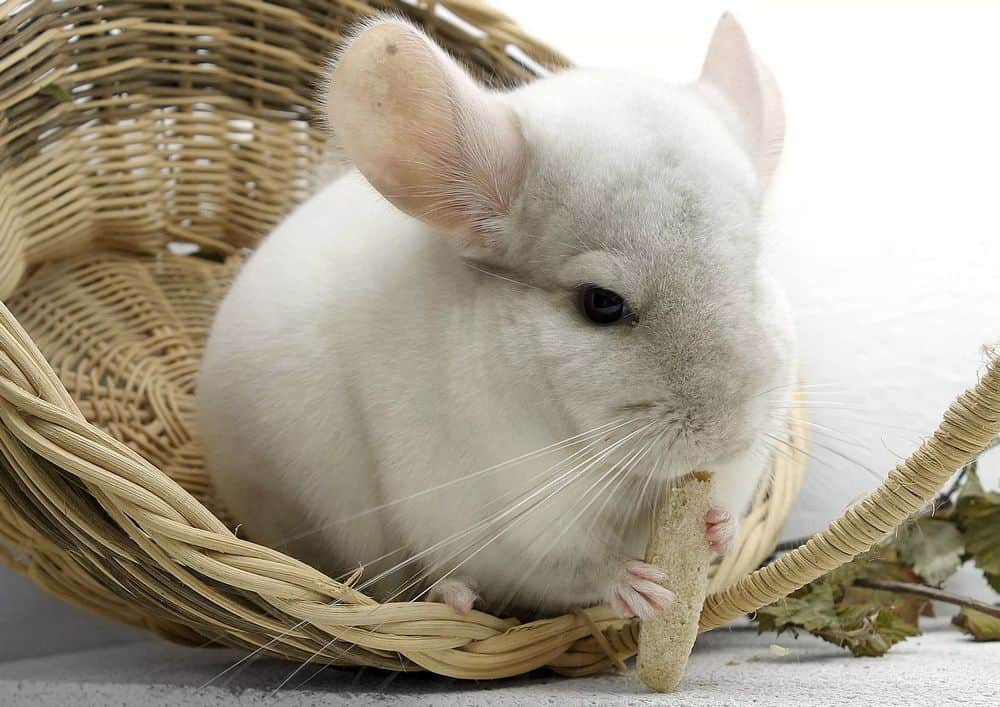
Bust out the bag of chinchilla treats. Shake them, open them, and place a few on the floor in a few rooms and call your chinchilla’s name. If she or he can hear you, you may be able to pull him or her out of hiding.
#2: Tap On The Dust Bath Container
This is my favorite technique on the list. Because it works. Begin training your chinchillas at a young age to associate a dust bath with something rewarding.
I do this by always offering treats during a dust bath. And when I try to get her into her dust bath, I begin tapping on the dust bath container with my finger.
As a result, this tapping now represents treats and an excellent time in the dust bath.
My breeder taught me this trick, and I just kept it going. Use this if you can’t find your chinchilla in the home to see if you can lure it out.
Just make sure to follow through and give it the dust bath and treat when it does come out. You want to make sure that this same trick works in the future as well.
#3: Follow The Chinchilla Poop Trail
We all know that chinchillas poop about as often as we blink. Non-stop. If you are having trouble finding your chinchilla in the home after some free-roaming, start looking by following the poop trail.
There is no way you can have a chinchilla loose in the house and not be able to locate some form of poop nuggets. While they may not lead you directly to your chinchilla, they can at least provide some clues a to where your pet may be hiding.
Follow the poop and be your chinchilla’s hero. Return it safely to the cage.
#4: Leave The Cage Door Open
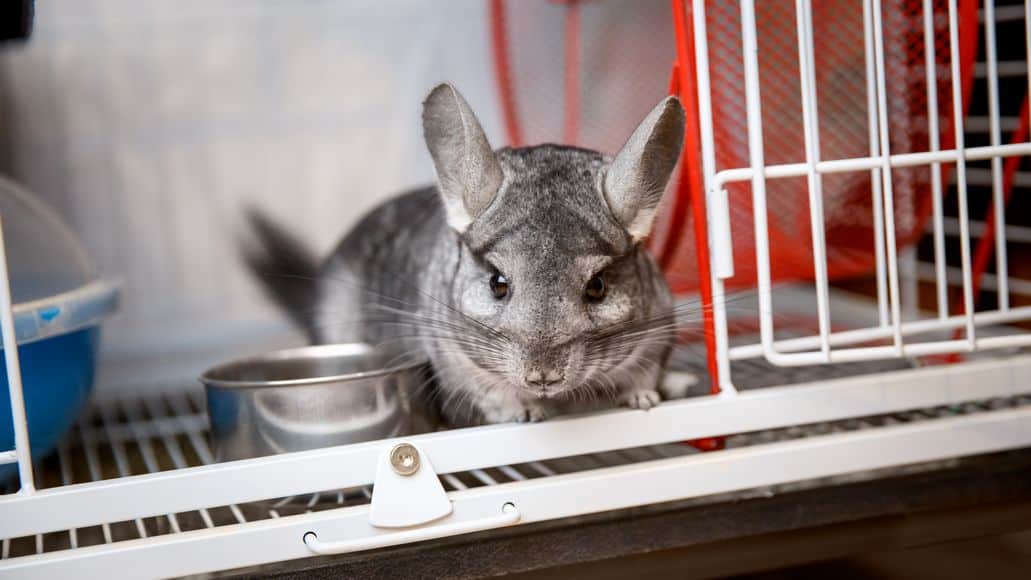
Some people think that their chinchilla cage is more like a chinchilla prison. This is absolutely not true. Especially if you take good care of your chinchilla, provide adequate space and keep the cage clean.
If this is the case, your chinchilla likely feels very safe in its cage. So when you can’t find your pet, try leaving the cage door open.
You may be surprised that your chinchilla will just return to the cage on its own after an excellent long adventure wandering the home freely. This won’t always happen, but it’s always worth a try.
#5: Call Your Chinchilla’s Name And Hope For A Response
This will likely not work very well and depends heavily on how well your chinchilla recognizes you as the owner and recognizes your voice. Some chinchillas respond very well to their owners and their own names, and some don’t quite have this skill down.
Nonetheless, chinchillas are extremely smart animals and deserve credit. If you can’t find your chinchilla in your home, begin searching the house slowly, by walking around with treats while calling your chinchilla’s name in a calming and welcoming tone.
It may just work for you.
#6: Wait It Out And Keep The Entire Home At A Safe Temperature
Sometimes, it’s going to take patience. I personally haven’t been in the situation with my chinchilla where it took multiple days to locate her, but it has happened to other chinchilla owners.
If this is the case, be sure to leave food and a dust bath out, in case it comes out of its hiding spot. Remain calm and patient and keep trying variations of the tricks and tips in this post.
I’m sure everything will turn out just fine for you. Hang in there. He or she will come out to greet you soon.
Chinchilla Roaming The Home: Final Thoughts
A chinchilla should never be roaming your house freely with access to multiple rooms. There are simply too many dangers out there.
Chinchillas should enjoy playtime with you in a controlled area where you can keep them safe and under your supervision.
Chinchillas make fantastic pets, and with some basic care and common sense, you can enjoy owning a chinchilla for the next two decades.
Chili and I wish you the best of luck with your new chinchilla and the journey you have ahead of you.
What are your thoughts about a chinchilla free-roaming the house?
As always, I appreciate you guys stopping by.
I’d love to hear your stories about your chinchillas free roaming the house.
Do you allow your chinchillas to roam your house freely?
How do you get your chinchilla to come out of hiding when he or she is lost in the home due to free-roaming?
Be sure to share those thoughts, stories, and concerns by dropping a comment below.
Chili and I appreciate you and we will see you again next time!
Kian says
Last christmas in 2019 my dog got and killed my chinchilla I got a new one the day after now I never take him out of his cage unless my dog is in his kennel.
Josh Martin says
That’s unfortunate and I’m very sorry to hear that. Yes, most of the time, dogs can’t be in the same room as a chinchilla out of the cage. Most dogs don’t understand or know any better but to act in this manner. This doesn’t mean it can never happen for some individuals but for most, it’s not possible. The kennel is a great idea for your dog during your chinchilla’s playtime out of the cage. I wish you the best of luck with your new chinchilla and thanks for stopping by.
Haley says
I’m getting 2 chinchillas soon but we don’t have very much room in the house. We can only keep them in our living room. How would you suggest we go about playtime and letting them out of the cage?